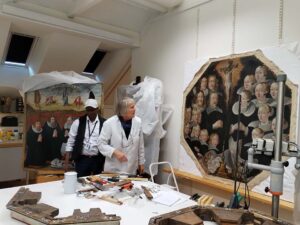NKS Rogaland avdeling og NKS Faggruppe for kjemiens historie arrangerte medlemsmøte med omvisning og foredrag ved Arkeologisk Museum tirsdag 12. september 2023.
Førsteamanuensis i kjemi ved museet, Kidane Fanta Gebremariam var omviser og holdt et spennende foredrag om kjemi i møte med kulturarv. Blant annet fikk vi høre om kjemiske analyser av pigmenter og bindingsmaterialer i malerier, stein-, mørtel- og pussundersøkelser, jord- og metallanalyser samt radiodatering. Under omvisningen ga også Anne Ytterdal eksempler på hvordan konservatorene jobber med kirkekunst fra Stavanger domkirke.


Abstrakt for foredraget v/ Kidane Fanta Gebremariam (UiS):
Chemistry in the service of understanding human culture: Highlights from physicochemical investigations of cultural heritage materials
Archaeology covers the study of the history of human past, in different periods and locations, based on artifacts and diverse remains. The materials left by people can be produced, adapted, altered, or utilized ones. Sometimes, as in the case of prehistoric periods, the archaeological finds and features constitute the only extant traces about an ancient society or civilization. Even in historic periods, in which written documents can be consulted, information about how the artefacts were used, the technology employed to produce them, sources of raw materials, how they were traded, etc. may not be available. Consequently, there is reliance on the study of the artefacts, materials, monuments, and the sites themselves from multidisciplinary perspectives. Chemistry provides one of the interpretations from the physicochemical perspective to address archaeological questions. In addition to the sources of materials and the production technologies, it is important to understand alterations of materials with time due to usage and other anthropogenic effects, history of their storage conditions and burial environments, as well as prior conservation treatments. This presentation covers some physicochemical investigations carried out on multiple heritage materials from different eras found in Norway and beyond. The determinations of the compositions and microstructures of these materials to facilitate archaeological interpretations, documentation of the heritage materials and assessing their conservation states will be highlighted. Archaeometrical investigations are multidisciplinary in nature involving the participation of archaeologists, historians, curators, and conservators to mention very few. Gleams of what it is like to work at the interface of natural science, technology, humanity, and art will also be provided.
